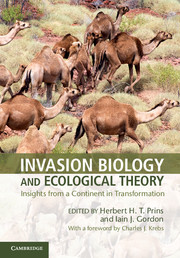Book contents
- Frontmatter
- Contents
- List of Contributors
- Foreword
- 1 Testing hypotheses about biological invasions and Charles Darwin’s two-creators rumination
- Part I Ancient invaders
- Part II Modern invaders
- 13 Invasion by woody shrubs and trees
- 14 Modern tree colonisers from Australia into the rest of the world
- 15 Failed introductions: finches from outside Australia
- 16 The skylark
- 17 Why northern hemisphere waders did not colonise the south
- 18 Weak migratory interchange by birds between Australia and Asia
- 19 Introducing a new top predator, the dingo
- 20 The European rabbit
- 21 The rise and fall of the Asian water buffalo in the monsoonal tropics of northern Australia
- 22 A critique of ecological theory and a salute to natural history
- Index
- References
18 - Weak migratory interchange by birds between Australia and Asia
from Part II - Modern invaders
Published online by Cambridge University Press: 05 February 2014
- Frontmatter
- Contents
- List of Contributors
- Foreword
- 1 Testing hypotheses about biological invasions and Charles Darwin’s two-creators rumination
- Part I Ancient invaders
- Part II Modern invaders
- 13 Invasion by woody shrubs and trees
- 14 Modern tree colonisers from Australia into the rest of the world
- 15 Failed introductions: finches from outside Australia
- 16 The skylark
- 17 Why northern hemisphere waders did not colonise the south
- 18 Weak migratory interchange by birds between Australia and Asia
- 19 Introducing a new top predator, the dingo
- 20 The European rabbit
- 21 The rise and fall of the Asian water buffalo in the monsoonal tropics of northern Australia
- 22 A critique of ecological theory and a salute to natural history
- Index
- References
Summary
Long-distance migration is a feature of the terrestrial avifaunas of most continents, notably those of Eurasia and North America. There, lengthening spring days and warmer temperatures prompt millions of birds to move towards higher latitudes (see Alerstam 1990; Berthold et al. 2003; Greenberg and Marra 2005). Among the most spectacular of these migrations are the millions of waterfowl and shorebirds migrating between high-latitude breeding grounds across the Holartic and non-breeding grounds in the southern hemisphere, and the annual movements of songbirds, raptors and others between the forests of the Neotropics and breeding grounds in North America. Yet among terrestrial species (except shorebirds) only seven migrate to Australia from a pool of 234 Palearctic species that migrate to South East Asia (Dingle 2004, 2008). All seven are non-breeding migrants to Australia, of which only three, oriental cuckoo Cuculus optatus, white-throated needletail Hirundapus caudacutus and fork-tailed swift Apus pacificus are common visitors (Dingle 2004). It is this dearth of migration between Australia and Eurasia that is our primary focus here.
For a wide range of Australo-Papuan landbird species there is no broad environmental condition likely to warrant an ‘out of Australia’ response to Asia or further afield. The resources they need can be found elsewhere within Australo-Papua. In the south, swift parrots migrate hundreds to thousands of kilometres from Tasmania to the mainland seeking widely dispersed nectar and psyllid resources in the Austral winter (Saunders and Heinsohn 2008). As winter develops, southern populations of rainbow bee-eater and others migrate north and some depart the continent to New Guinea and islands beyond. In the north, pied imperial pigeon, metallic starling, buff-breasted paradise kingfisher and others migrate annually between the tropical forests of northern Australia and New Guinea to exploit seasonally available resources (e.g. Legge et al. 2004). A key feature of migration within Australia is the preponderance of partial migration, the phenomenon of some populations or individuals and not others of a species undertaking migration. This arises through variable responses of individuals and populations to irregular weather patterns and subsequent uncertainties of the whereabouts and availability of food resources (Chan 2001). For Palearctic migrants passing through the archipelagos of South East Asia, this uncertainty likely precludes extending migration to the Australian continent, except to habitats that are reliably productive in the Austral summer, such as the coastal habitats used by migratory shorebirds.
- Type
- Chapter
- Information
- Invasion Biology and Ecological TheoryInsights from a Continent in Transformation, pp. 389 - 413Publisher: Cambridge University PressPrint publication year: 2014

